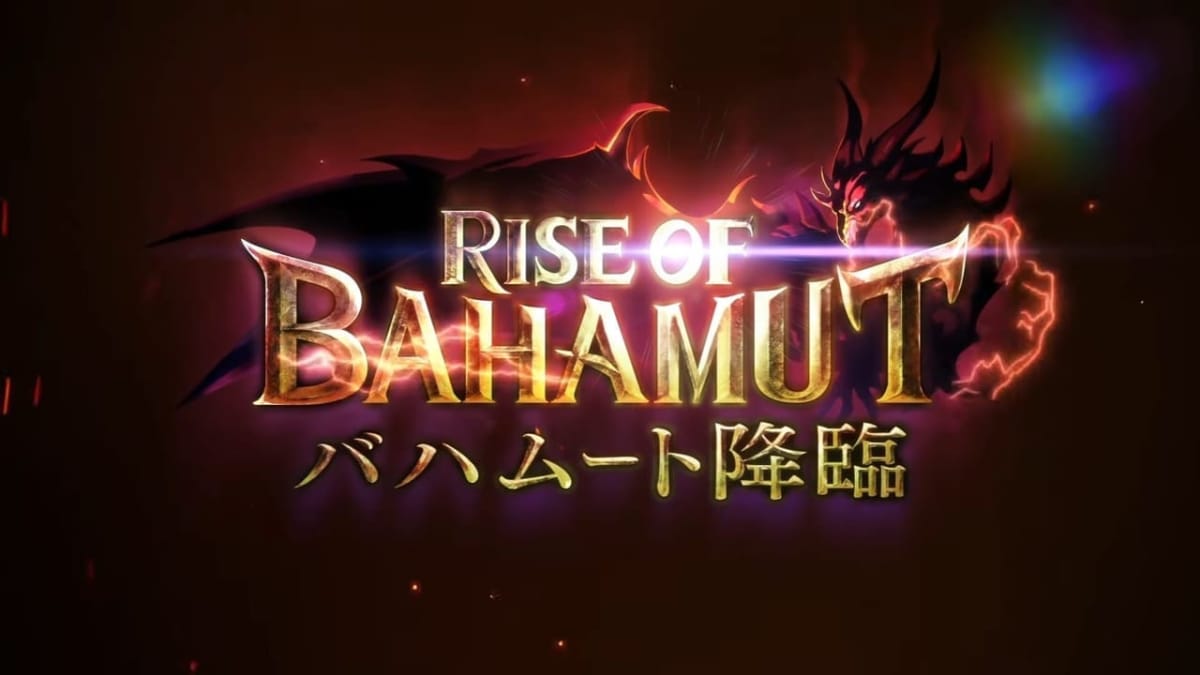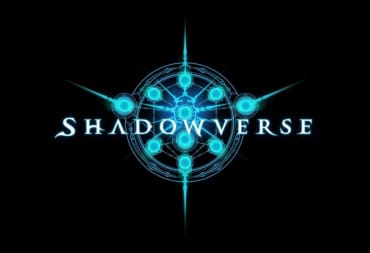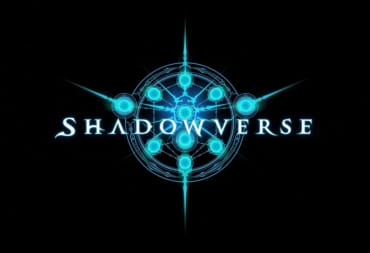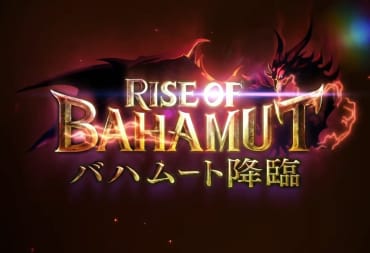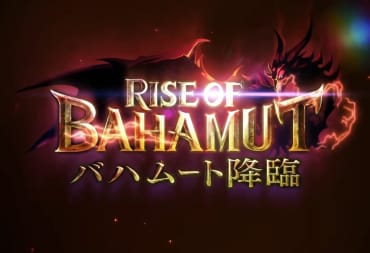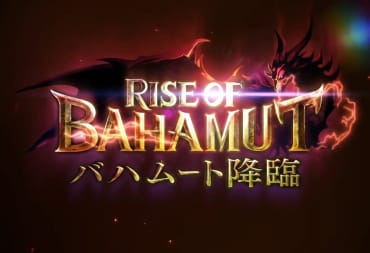Shadowverse is a card game by Cygames available on mobile devices and Steam. Though new, it has received raving reviews and is currently in the process of establishing their second expansion, Rise of Bahamut. Want to try the game out? Check out our Shadowverse Competitive Primer series to learn how to get started in Shadowverse!
The next batch of Rise of Bahamut cards has been revealed on the official Shadowverse Twitter and their forums. Just like the last batch, they seem to be a mishmash of rarities from various leaders. This post will cover in-depth analyses of the cards as they relate to the current state of the ranked metagame. For just summaries of the cards and other Rise of Bahamut news, check out this article and check out over here for Part 1 of our Shadowverse Rise of Bahamut analysis.
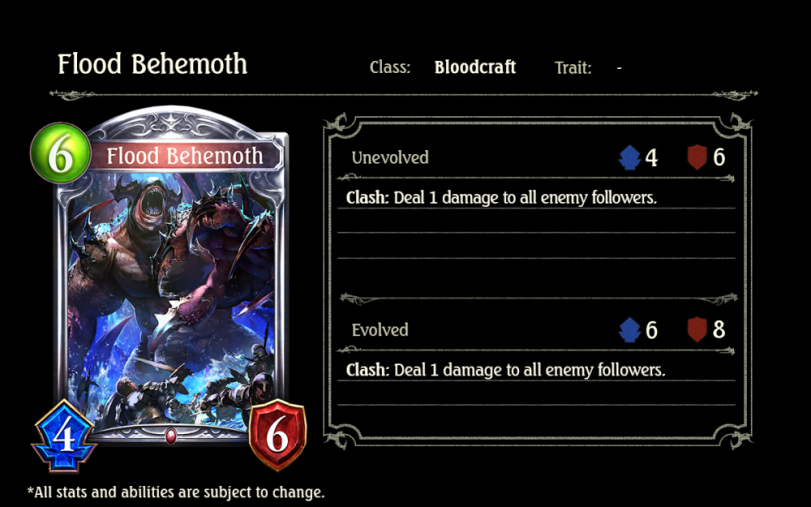
A six-point 4/6 is just a little below average in terms of stats, but since the other Bloodcraft six-point drops are all quite good, Flood Behemoth needs to stand out. Imp Lancer is a 3/6 with Storm, Medusa is a 5/4 that banishes on attack, Rampaging Giant and Demonic Thrall are 5/6 with added bonuses under the Vengeance effect, Queen Vampire provides two 1/1s with Ward, and Demonic Storm is a powerful board clear though it clears both sides. Additionally, out of these, only Demonic Storm, Queen Vampire, and Imp Lancer really see play, as even a control-based Bloodcraft deck prefers fast, immediate benefits in the late game.
How does Flood Behemoth stand out, then? Like the card Thief revealed and analyzed in the last article, Flood Behemoth has a Clash effect that activates when it deals damage or is damaged. The effect of dealing one damage to all enemy followers is very similar to Angelic Barrage, a three-point spell commonly run as tech versus aggressive, swarming decks. To have that effect simply added onto a somewhat significant body seems good, at least at first. Under most circumstances, especially if this is evolved, the effect should trigger at least once, as 4/6 is often too big to be ignored. Additionally, this can help clear the board of the smaller followers that aggressive Swordcraft, Forestcraft, and opposing Bloodcraft decks tend to swarm with. This card could prove especially useful in dealing with Crystalia Tia after it summons the 6/6 Crystalia Eve, which usually happens turn six or seven; after being evolved, it can clear Eve with two defense remaining, and the effect can wipe the rest of the board.
In practice, this card may not be as effective as the dream scenario above predicts. In aggressive Bloodcraft decks, it definitely loses its spot to the immediate damage that Imp Lancer or Demonic Storm provides, and also has competition with the newly revealed Mastema. With Bloodcraft decks that try to stay at the Vengeance activation level of ten defense, this card is still arguably outclassed by the other cards that receive benefits from Vengeance, or even by Demonic Storm, which can clear a board of more than just one defense followers, as well as doing direct damage. Finally, being played after turn five means that this card is particularly susceptible to hard removals from Execution, Dance of Death, and more. While this card has an interesting Clash effect that helps clear the opponents board, it faces competition from followers with more useful effects and Demonic Storm, a more significant board clear.
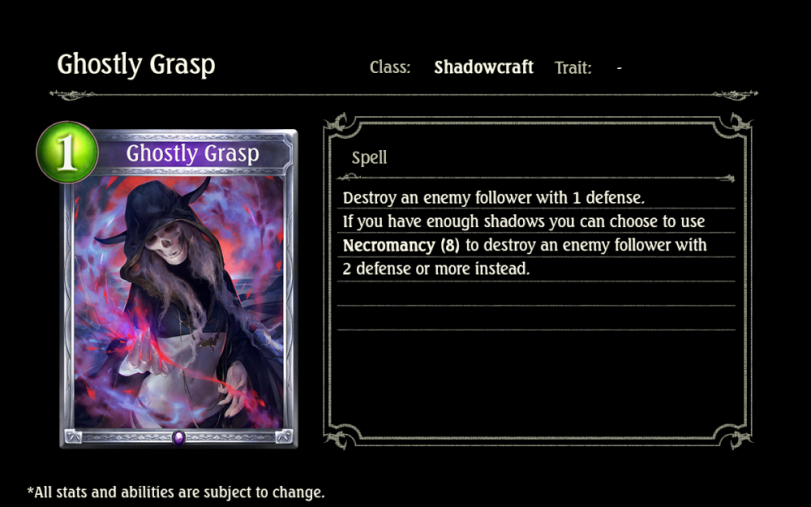
Shadowcraft receives yet another follower removal card, which joins Deathbrand, Call of the Void, Dance of Death and Execution as options. Ghostly Grasp appears to be a Deathbrand with a higher Necromancy cost to have the situational effect removed; while Deathbrand has a higher threshold before requiring a Necromancy cost, Ghostly Grasp only costs one point compared to Deathbrand's three.
The one point cost means that Ghostly Grasp can be played far more flexibly. The catch is, however, that the eight Shadows required are not as easy to come by as Deathbrand's four. It would require a very ideal situation to reach eight shadows before turn five, and Ghostly Grasp must compete for shadow use with other cards, such as Undying Resentment, Charon, and Foul Tempest, among others. Though the one point cost to remove a follower with one defense (an inferior version of dealing one damage to a follower for one point) can come in use versus aggressive decks that swarm the board with one defense followers, Foul Tempest or Angelic Barrage seem far more efficient in terms of cost and card use.
Where Ghostly Grasp really could shine is in the late game, where, if Burial Grounds was played earlier in the game, shadows may have begun to accumulate without being used. At that point, this card becomes an extremely efficient follower removal and can be played alongside late-game cards, such as Lord of the Flies and Mordecai the Duelist to surprise the opponent. While most current Shadowcraft decks do not run excessive shadow gain, the powerful efficiency offered by this card, especially in late game, may result in people editing their decks to fit it in.
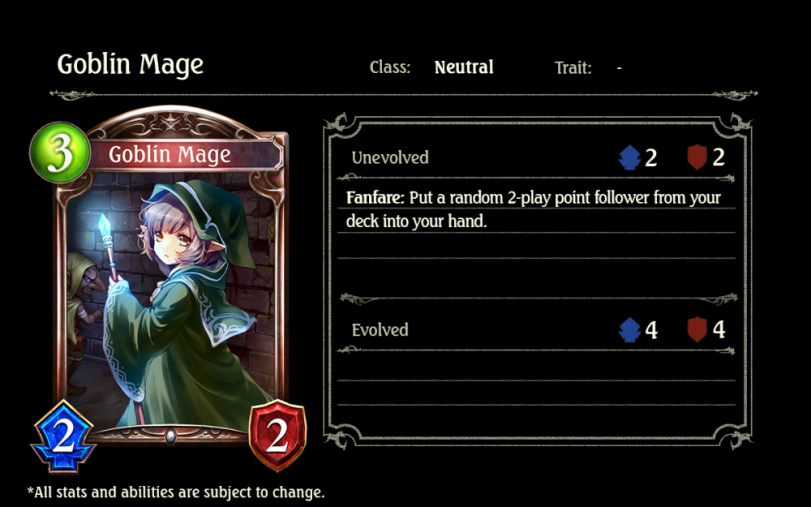
Three points for 2/2 stats is below average, even when compared to other neutral cards. However, Goblin Mage offers a powerful deck searching effect. Two point followers are prolific in every deck, from the useful neutral tech card Unicorn Dancer Unica to Bloodcraft's quickly aggressive Blood Wolf to Swordcraft's helpful search card Maid Leader. Given the useful things that Goblin Mage can dig out, it then becomes a question of how useful this effect actually will be when played.
As a three point drop, this card can only be played on turn three and beyond, meaning it will not support a desperate turn two hand. While it faces competition from a plethora of other three point followers from various classes, its searching effect is unique, and it should be evaluated on those merits. If played on turn three, this card can provide the option of playing two two-point cards on turn four, which is helpful in establishing early game momentum. While this card, like many other low cost cards, drops significantly in usefulness as the game goes on, it does at least remove two point followers from the deck, meaning they won't be drawn as desperate top-decks.
Where this card really shines is in decks that attempt to dominate the board with their two point followers, most notably Swordcraft and Forestcraft archetypes. This card can help find those important cards, such as Centaur Vanguard for quick damage or Elf Girl Liza to protect a developed board from being cleared by a spell, and may make those decks more reliable to play. While there still is some randomness with Goblin Mage's effect, its searching ability is very useful, and it may find a place in decks that focus on their early game, two point followers.
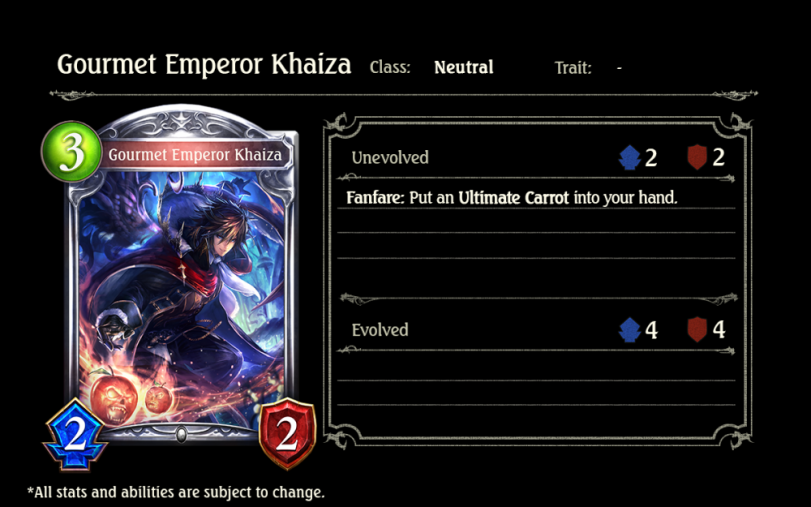
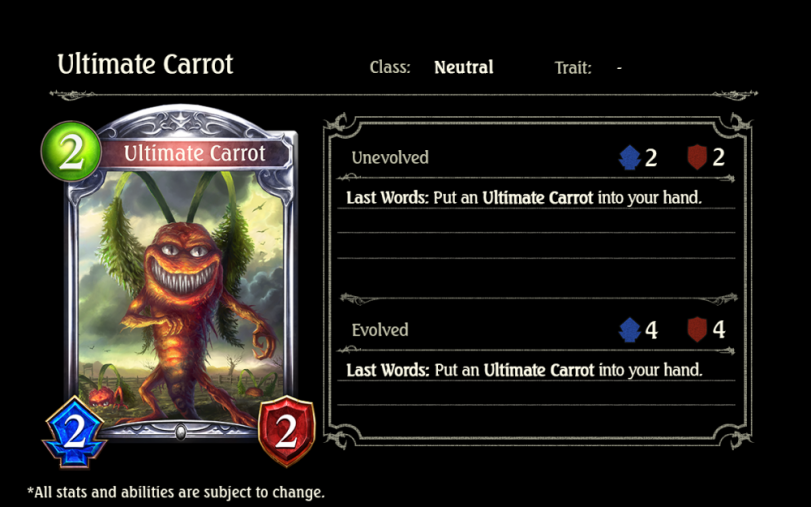
Following the previous three-point neutral follower is another three point neutral follower with the exact same stat line. Like Goblin Mage, Gourmet Emperor Khaiza provides a new service, this time, generating a two-point 2/2 follower that reappears in the hand when it is destroyed on the field. Khaiza's three-point 2/2 stat line is fine given that it brings in the real star of the show, Ultimate Carrot.
Ultimate Carrot's two points for 2/2 stats is decidedly average, maybe even a little less given that most leader specific followers with those stats provide added benefits. While cycling through a never ending stream of Ultimate Carrots may seem attractive, small followers become less and less effective later in the game. Additionally, the requirement of playing the less efficient Gourmet Emperor Khaiza before being able to play Ultimate Carrot means that this card is even less useful. While early-game aggressive decks that lack card draw may enjoy a consistently respawning Ultimate Carrot to help swarm the field, in the end, it offers less efficiency than other available options. It is also important to note that being at two defense means this card is easily banished by Havencraft's Blackened Scripture or Priest of the Cudgel, completely negating its Last Words.
Dreams of Gourmet Emperor Khaiza into an infinite flood of Ultimate Carrots may be sweet, but in the end, this card doesn't provide enough to warrant a spot on the dinner table.
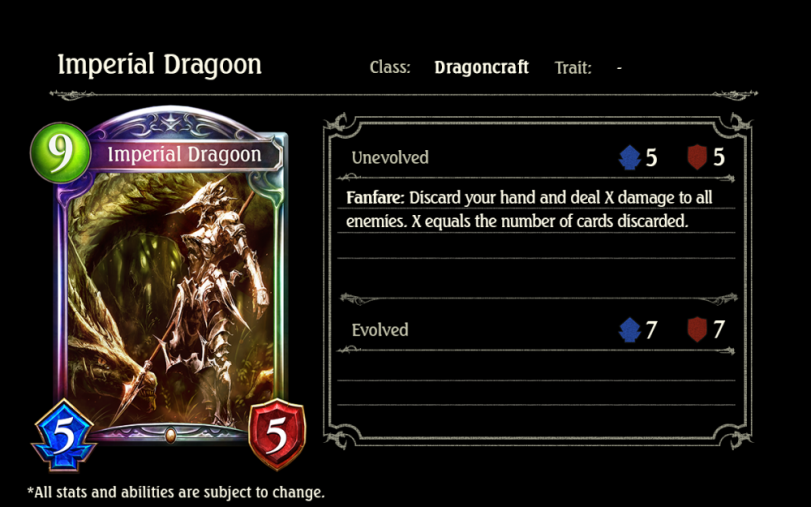
Dragoncraft's new legendary boasts a vastly inferior stat line of 5/5, compared to the class's other 9 point legendary, Fafnir with 8/10. In order to warrant this, Imperial Dragoon needs to provide an effect that is both useful and unique. The effect certainly is unique, sacrificing the entire hand to deal damage to the opponent's leader and board equal to the amount of cards discarded. In Shadowverse, damage that only targets the opposing leader is rare, and Imperial Dragoon's effect is especially interesting because it can even hit eight damage if the player has a full hand before playing this card. Eight direct damage with one card can only be challenged by Genesis Dragon played and evolved against an opponent with no Wards, dealing a total of nine damage to the opposing leader.
Despite how powerful Imperial Dragoon's effect can be, a quick look brings it down to earth. Discarding an entire hand is a risky proposition at best, and Imperial Dragoon's stat line hardly warrants the sacrifice. Though hitting the opponent directly is attractive, it becomes a lot less so when one realizes that Imperial Dragoon costs nine points to play, and gets a meager 5/5 onto the board. Though an aggressive Dragoncraft deck may find this finishing damage attractive, maintaining a hand large enough to do significant damage provides a problem in itself. Though Dragoncraft has hand regeneration in Shenlong and Dragon Counsel, most of their card cycling is one for one.
Imperial Dragoon does synergize quite well with one specific Dragoncraft card: the amulet Dracomancer's Rites. This card allows the player to redraw their entire hand after Imperial Dragon discards it, basically getting the damage for free. However, this still does not justify playing a 5/5 stat line for nine points, and Dracomancer's Rites is not a commonly run card, even in Dragoncraft decks with discard mechanics. Imperial Dragoon uses one of Dragoncraft's often forgotten mechanics, discarding, to deal direct damage, but unless discarding gets additional support in Rise of Bahamut, this card's stat line dooms it to mediocrity.
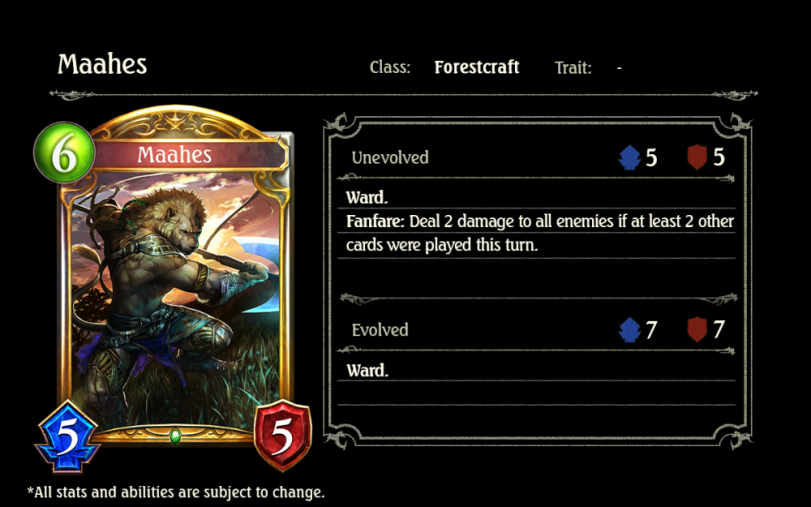
A six point 5/5 is average statwise, but Forestcraft has its pick of six drops. Elf Knight Cynthia can add quite a bit of damage and a 5/6 body to an already developed board, and Fairy Beast is great at healing off damage to stall for time and draws. Outside of those two commonly played cards, Maahes still must compete with Elf Tracker, Grand Archer Selwyn, Fairy Princess, Magna Botanist, Elder Treant, and Master of the Canopies, all of which provide great support buffs or significant stats under the right circumstances.
Maahes has two methods of standing out. The first is Ward, which, given its 5/5 stat line and six point cost, is efficient and can definitely slow down opponents without hard follower removal. The second, which occurs after two cards have been played, deals two damage to all enemies, which includes the opponent's leader. This is an extremely potent effect, as two defense is a threshold the followers in many board swarming decks barely meet (Sea Queen Otohime is a notable example), meaning Maahes not only provides Ward for blocking aggressive attacks but clears common aggressive boards as well.
In order to activate the powerful second effect, however, two cards must be played before Maahes. As Forestcraft consistently spawns Fairies, this effect realistically can activate on turn eight or later; although, with cards such as Elven Princess Mage, it can trigger as early as turn six. The board clearing effect combined with a great 5/5 body and Ward definitely make Maahes an amazing anti-aggressive card for Forestcraft decks, and a generally powerful and efficient follower for six points.
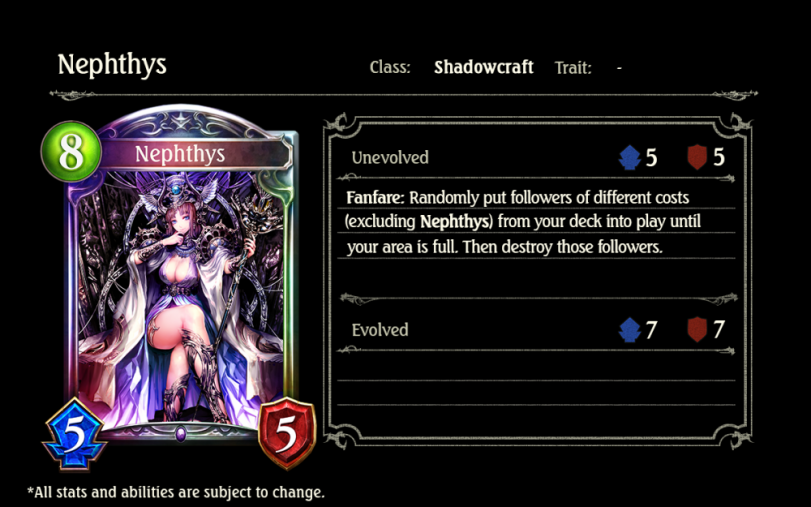
At eight points for 5/5 worth of stats, Nephthys exactly matches Mordecai the Duelist in terms of stats. However, Mordecai has the powerful ability to continually respawn on the field if it is destroyed, making banishing or transforming it the only real options to remove. To compete, Nephthys brings its own unique effect: flooding the board with minions from the deck, then destroying them all.
This immediately brings to mind building a deck around her and Last Words followers, which Shadowcraft has many of. From the early game Skull Beast and Spartoi Soldier to mid to late game Mordecai the Duelist and Hell's Unleasher, there are many cards that provide benefits if destroyed. And while getting two Mordecai the Duelist and two Hell's Unleasher would be a dream, even getting two Last Words, such as a Hell's Unleasher and a Bone Chimera still provides one with an extra 4/4 and two 1/1s, giving 11/11 worth of stats for eight points. However, Nephthys does run the unpredictable risk of drawing out somewhat useless cards, such as those with Last Words that do not provide board advantage or cards without Last Words at all; it would be bad to summon Prince of Darkness only to destroy it. Still, with an empty board, Nephthys provides four chances to get a useful card, so a spell-heavy Shadowcraft deck can work to control what followers Nephthys may summon.
Nephthys is also a very slow play, as, without an Evolution, it doesn't provide any significant immediate presence. If it draws out Ghostly Rider, it can at least help get a Ward on the board. On turn eight and later, it may not be recommended to have such a slow play, but Shadowcraft's efficient control spells may make it viable. The new Shadowcraft legendary offers immense value if it draws out one or two of the better Last Word cards, but its randomness and slowness may be its downfall.
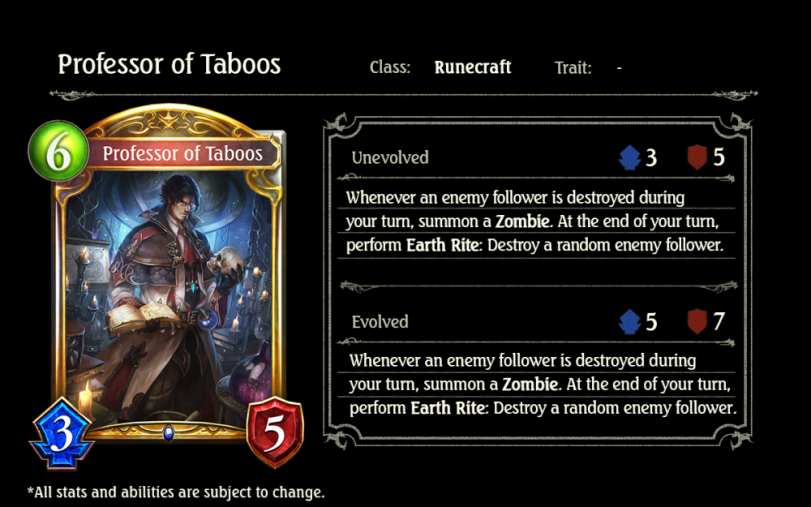
A six point 3/5 follower is weak. Nevertheless, Professor of Taboos offers a new, more offensive option to the Earth Rite playstyle that Runecraft can run, competing with the other six point followers Shadow Witch, Gem Golem, and Master Alchemist. It cannot be directly compared to Calamitous Curse, however, as the spell provides an amazing board clear of the opponent's side.
Professor of Taboos is an offensive alternative to the other options despite its inferior stats. With an established board presence, which Earth Rite can easily maintain due to their cheap but delayed Guardian Golem summoning cards, a series of trades into opposing followers can both clear the opponent's board and keep board presence with summoned 2/2 Zombies. The Earth Rite effect can help destroy opponent's followers that are too large to trade into, provided that there is an Earth Sigil on the board.
However, Professor of Taboos has its downfalls in holding board control. With a limit of five followers or amulets on the board at a time, this card's respawning ability may be hindered by the amount of cards already there, as well as the Earth Sigils being played to feed into its effect. Professor of Taboos offers an interesting offensive option for an Earth Rite deck's six-point follower, but limited board space and the unpredictability of this card may prevent it from seeing play.
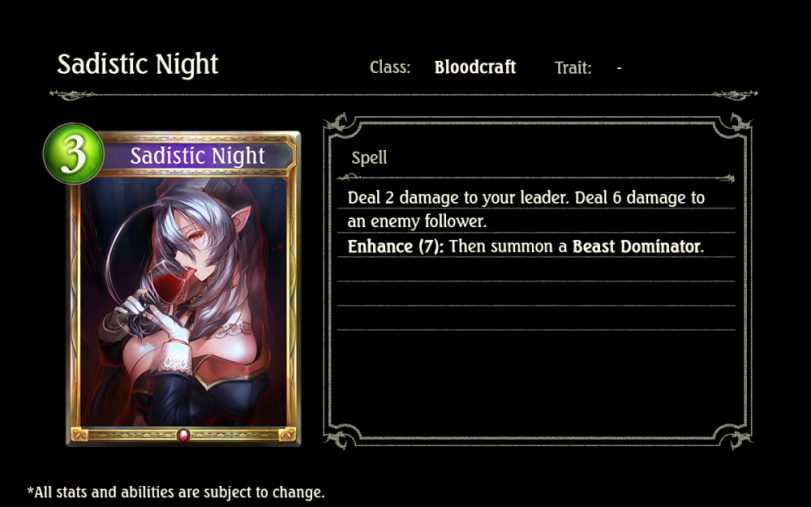
This is yet another Bloodcraft damage spell, joining Blood Rage, Razory Claw, Diabolic Drain, and Vampiric Kiss. At three points to deal six damage to a follower, this is one of the most efficient follower damage dealers in their arsenal, beaten only by Diabolic Drain when under Vengeance. However, given that Blood Rage, which reaches similar levels of efficiency when under Vengeance, is rarely played, what makes Sadistic Night stand out?
Without looking at its Enhance effect, the only real boon this has is that it can be combined with Bloody Mary to deal a little extra direct damage in control Bloodcraft decks; its efficiency definitely makes it an appealing option for removing opposing followers there. When used with seven or more points, this card summons a Beast Dominator, a 6/6 follower that damages the leader and loses two attack if Vengeance is not active. Seven points to deal six damage to a follower and summon a 6/6 is a very powerful effect if it only costs two defense, which will occur at twelve defense or below. Additionally, because Beast Dominator's effect activates only at the start of the turn, it is always a 6/6 at first, so it can still retain those stats when evolved. The main other seven point card played in Bloodcraft is Alucard, who provides completely different benefits.
If the leader is at thirteen health or above, this card costs four defense and summons a 4/6 along with its other effect. That still makes this card surprisingly efficient, and while one must be careful with Beast Dominator and taking damage, Sadistic Night may actually find play in Control Bloodcraft decks that will try to play this card to its strengths.
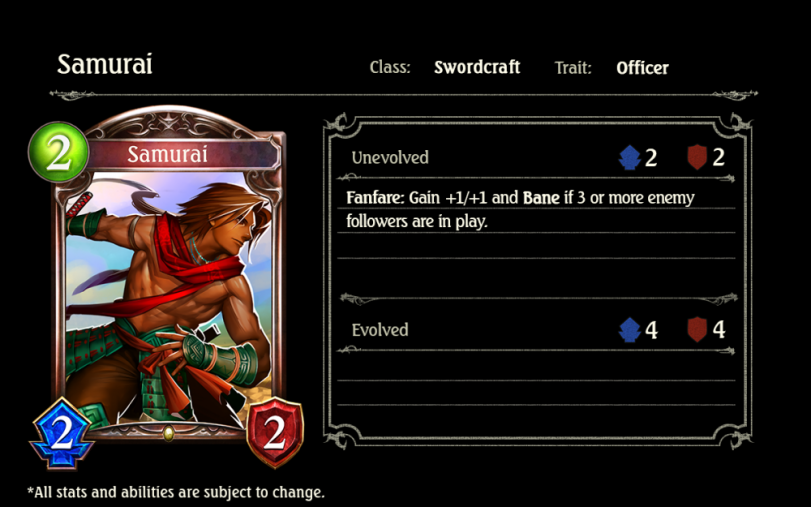
Yet another two point 2/2 card, competing with Centaur Vanguard, Maid Leader, Oathless Knight and more for a place in a Swordcraft deck. As opposed to offering direct benefits like the above mentioned cards, Samurai only gains in strength when the opponent has a well-established board of three or more followers, at which point this becomes a 3/3 with Bane. Realistically, most decks except Swordcraft will not have three cards on the board by turn two, and definitely not if they go first, meaning Samurai is inferior to even Unicorn Dancer Unica at that point.
Not only is this card irritatingly situational, it also plays slowly. A 3/3 with bane for two points is very efficient,but unless evolved, there is no way to ensure this card takes down the correct target. Ruthless Assassin is one point more expensive but far more easy to trade in if there is a Commander already on the board. In addition, against an already well-established early game board, Swordcraft may prefer to play more or faster followers to trade in rather than strong, single ones, making Oathless Knight and Centaur Vanguard more appealing options. Against aggressive decks with one health followers flooding the board, Angelic Barrage or even Unicorn Dancer Unica would be better cards to play.
Samurai is a very efficient card under the right situations, offering 3/3 in stats and Bane for only two points, but Swordcraft has better two point followers and generally better options than this.
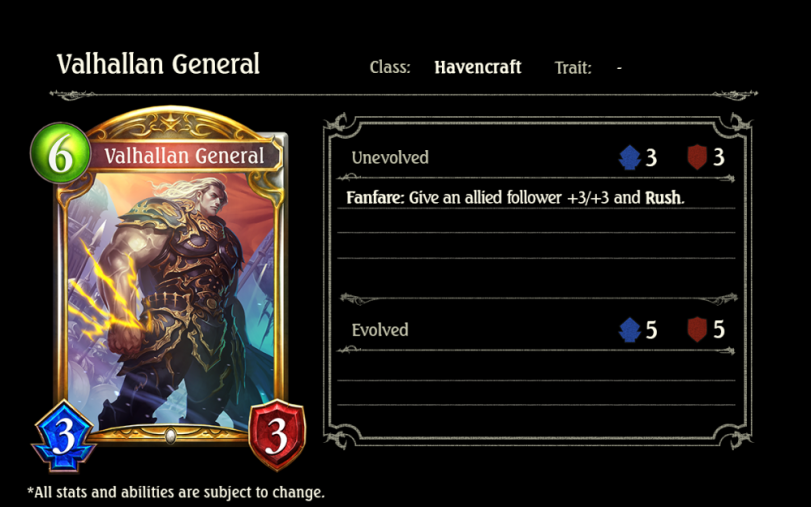
Six points for a 3/3 is bad, but given that this card also provides +3/+3 to another follower, it might be more apt to say that this is a six point 6/6. Additionally, the addition of the Rush ability is especially significant in Havencraft decks, where the followers summoned by their countdown Amulets may not be able to attack the turn they appear, adding a hidden extra turn to their effectiveness. Havencraft's main other six point followers are Moon Al-Mir'aj and Winged Sentinel Garuda, both of which provide more direct offensive benefits. The common Havencraft six-point spell, Themis's Decree, is a completely different type of card that clears the board for later.
Valhallan General's benefits are +1/+1 better than a typical Evolution, already making it a force to be reckoned with. While it can target a follower summoned on the same turn in order to help clear the board, it can also boost the Storm followers that aggressive Havencraft decks usually summon, giving them +3/+3 and dealing an equivalent amount of damage to the opponent as Winged Sentinel Garuda or Moon Al-Mir'aj, though Valhallan General does not bypass wards as Winged Sentinel Garuda does.
Because the only way to get rid of a countdown Amulet's followers before they're summoned is to banish or transform it—two very rare mechanics—Valhallan general will almost always be able to boost a follower. Its flexibility as compared to Moon Al-Mir'aj and added benefits as compared to Winged Sentinel Garuda means it is definitely viable for the six-point follower slot and may be run alongside one or the other.
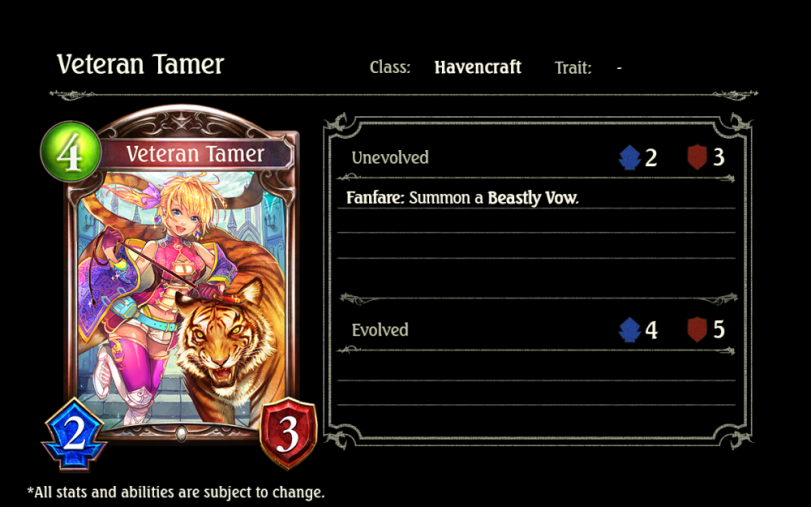
A four point 2/3 is quite a bit below average, but because this follower brings with it a two-point amulet, Beastly Vow, it may be more right to say that this is a two point 2/3, which is above average. The question is, then, is the added benefit worth it? Beastly Vow takes two turns to summon a 4/4 Holyflame Tiger, which itself requires another turn before it can attack if not Evolved. It is not a commonly run amulet, especially because Beastcall Aria provides a 2/1 with Storm at the same cost, though one turn longer wait.
Though Havencraft usually plays only two different four-point followers, they are both quite good. At almost any point in the game, Priest of the Cudgel can be evolved to eliminate two opposing followers, and Urd can "refresh" the Storm ability of a follower, allowing for more damage output in aggressive Havencraft decks. While Veteran Tamer does provide its own benefit in summoning a countdown amulet, it is a slow play that does not establish board control nor deal extra damage.
Like with many other Havencraft cards, Veteran Tamer offers efficiency at the cost of delayed effects; in this case, the equivalent of two two-point cards played on turn four or later, with one of them being a solid 2/3 in stats. While Havencraft does not have that many four point options, the two it has are more than enough, and Veteran Tamer is too slow and ineffective to run, considering the amulet is nothing special either.
As more cards are revealed, the future metagame of Shadowverse becomes more and more interesting. This particular batch introduces a few mid- to late-game cards that could serve as creative finishers. With the rate at which the Shadowverse Twitter is revealing cards, we hope to be able to keep up with our analyses here at TechRaptor and give you the best idea of what the Ranked ladder will look like after the release of Rise of Bahamut on December 29th.
Stay tuned to TechRaptor for more discussion on Rise of Bahamut Card reveals!
Update 12/12/16: Corrected a few grammatical/spelling errors and incorrect information about leader cards.
Have a tip, or want to point out something we missed? Leave a Comment or e-mail us at tips@techraptor.net
